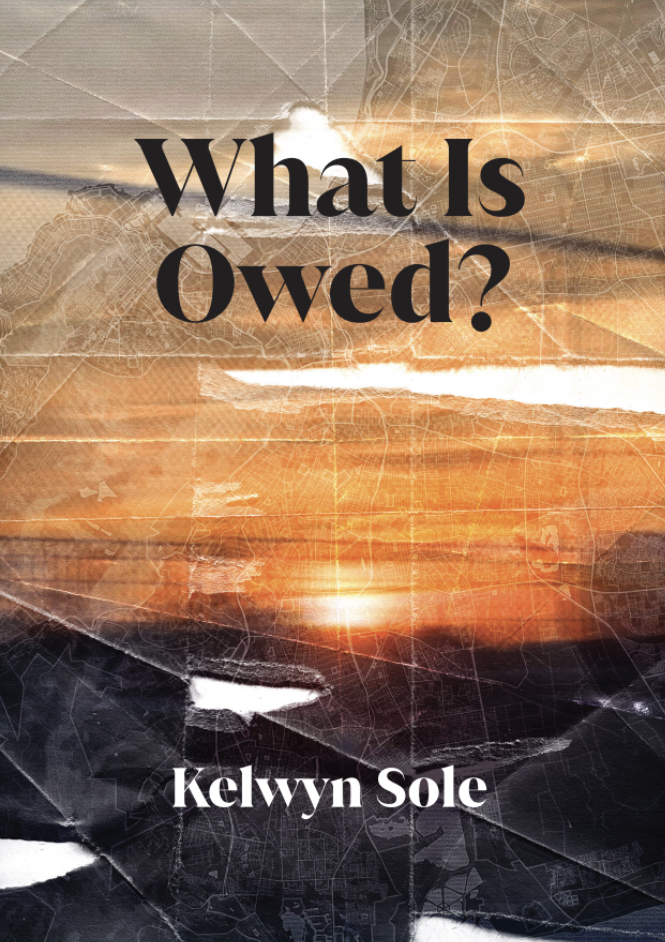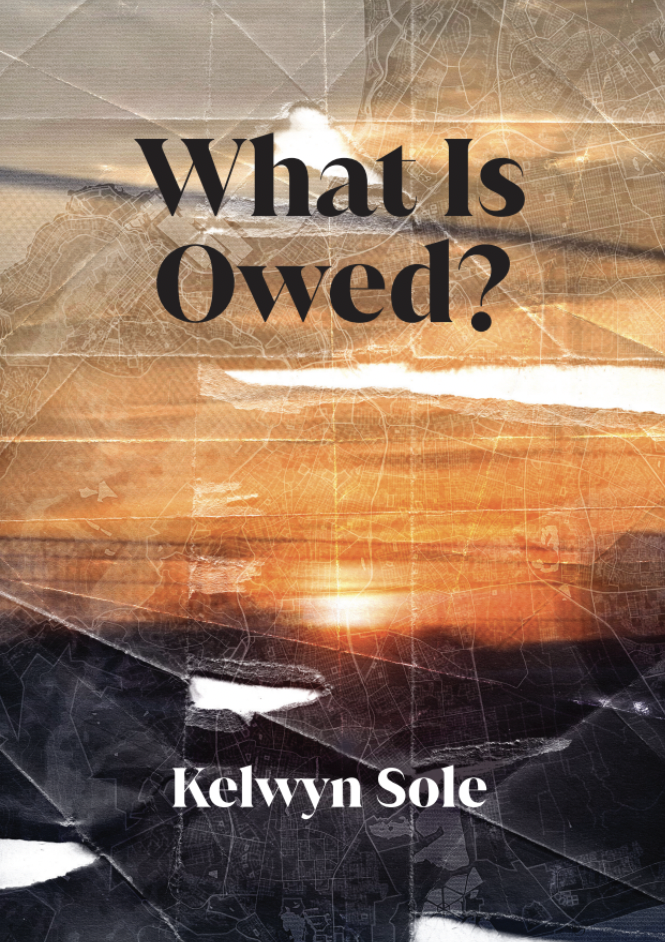By Phillippa Yaa de Villiers
Kelwyn Sole is an esteemed poet and literary scholar, and his latest, ninth collection of poetry, What is Owed? is absorbing, exciting, provocative and sexy. Its freshness is a tonic that instantly cures the malaise borne of reading much creative writing today which leans on ChatGPT, creating a daze of facile verbosity, with words shot out like that tennis ball machine to train professional players.
Sole has given full licence to every impulse to craft in registers from schoolboy naughtiness (Mooning the Moon, 64), to the elegiac (The House, 10-13), the political (The Leader’s Speeches, 18), the humorous (Letter to the Editor and The Spyder, 42-47), passionate nerdiness (Zen in the art of birdwatching, 38), the virile romantic and I can feel the online salesman shout, And there’s more! All because there is. So. Much. More. To. Read in this 106-page voluminous volume of poems. There are poems that make you cry and others that make you laugh out loud. With less of his characteristic reserve and more rampant enjoyment, Sole shapeshifts in this collection, appearing as an old man, as a trogon, as a bee, as the sun, as the beloved, with a sideways wink between author and reader. For example, what is Owed? appears as “What is (ode)”, and it doesn’t prompt the bland canned laughter of a pun, but a small snort which bubbles to laughter at “The clever words I’d penned for years lift their upstrokes/like alarmed warthog’s tails” (What is (ode), 99). Clever words indeed! Penned, like Claude McKay’s hogs! Oh, wild poet, your face smeared with images from the world of poetry! Your eye blazing for freedom! Your ear attuned to the sentience of each life form.
This collection sings the sentience of all creatures, houses, Styrofoam cups, and examines the natural world, family, relationship, connection, and their opposites. In Sole’s world, land and sea are in constant communion, they are fixed in dialogue with fluidity. In the first four-part poem the solidity of “The House”, is first undone by a razor-sharp image that sees beyond the brick and mortar to the architecture of relationship:
…held by a maze
of walls and rooms and corners, he found he
could never sidestep the doting eyes of adults
to dance his own dance, betrayed to them
each time by the dribbled of sand he forgot
to wash off his feet…
This speaker, “tricked by the ego of his childhood” is haunted by “an old chair in one corner (that) seemed to rock itself to sleep” and “the sigils of so many cockroaches and beetles” speaks to a long-held violence which reappears in the second part of the poem as “a shrapnel of shells…”
“…crumbled, grain by grain
the fragile certainties of your land?”
The third section of “House” deals with blood ties and family relationships. Sole summons the marine phenomenon of red tide to capture the destruction of “gasping fish and dead crabs” which mirror
“a life endured
By him and others by blood
far beyond a rickety family table”
This “blood” connection, echoing the diseased ocean at the beginning of the section, suggests a corruption in close ties, possibly violence.
In the final section, “the house, now empty, watches all…” If this nation of South Africa is this family house at the edge of the ocean, Sole flips the script and gives the inanimate the power to “watch”. Even with the comfort of a benign and indulgent contemplation of a parental house, the “soles of his childhood still chafe incessantly.” Is not this the complex inheritance of the white South African, the staples of discomfort, haunting, danger and fear, rendered through the images of a house, cockroaches, a family and a red, infected sea.
I do love all the poems in this collection, but I want to read “We, Briefly” (20) aloud, because I am intrigued by how lyric poets deal with complexity, and they retain the clarity of these images even when built into a pile – they seem to retain their integrity. “We, Briefly” reminds me of Sei Shonagon’s lists of social and natural phenomena, collected under two headings, “How we live” and “How we think”. The clarity of each of Sole’s visions places us in a world we can easily recognise.
After waking,
the homeless shuffle down the street
having slept fitfully in our legacy:
a bed of pitilessness.
The elements are characters in Sole’s poetry, complicated with sentience “a scorpion of wind, lashing its tail through drowsing houses” but the musical prevails, a deep listening to the sound of an image. The poet disappears, or maybe becomes what he sees, because of a Keatsian negative capability or is it satori, where the observer and the observed merge. Either way, the bird has flown; Sole’s stanzas are blinks, flitting images that dissolve into others. The speaker follows water after rains which “debouched into drains and sewers.”
For a child who is delighted in reading dictionaries it is always a joy to discover the strange words or roots or routes to whole new meanings. As I grapple with my addiction to the cheap and easy way slot machine bonanza of information called the internet, I’ve decided to look up word meanings in a physical dictionary. Making that small effort reawakens my childhood curiosity, with the now delectable restriction of time. Instead of skating over the surface of the poem and taking it as read (even though he tells us to in “Mooning the Moon”) I am arrested, entranced by a particular phrase, drawn into the labyrinth of the “embouchure of dawn” which delivers the mysterious dageraad and suddenly we’re in a biology lesson slash jazz performance where the poet spends decades lining up dominoes of images and then, with a wry smile, lets them go, unzips them as it were till the whole naked body of the world is revealed in its profanity, grossness and beauty. Every collection has its time, which is not just about duration but about the sensory memory that the poems pull the reader through. Sole is not an instant, convenient, just-add-water poet, a glittery show-off, or a class-clown crowd-pleaser, although at times the poems provide the entertainment value of a gladiatorial confrontation as we watch metaphorical MMA takedowns that pin the rich and powerful to the mat.
Sole creates worlds by entering others. To take issue with the banality of official communication, he conscripts the poor old lungfish – and I think that should have been the title of the poem. Although his outrage is appropriate and probably widely shared, the logical conclusions edge towards stridency and dull the sharp appointment of the lungfish as spokesman for the ruling party, foreclosing the poem’s argument. Because it is through the ironic and humorous that Sole, at his best, reckons with strangeness, the estrangement that is so familiar to his particular purview, which ultimately always reveals something new in the everyday, a new that is not always easy. Like getting old. Sole takes us with him into the ”Night Ward”
A dark forest of sleeping
beds rustling with breath
and in each one
the squirrel of pain
has found a place
to hide its nut. (89)
These poems beget metaphors: reading the collection felt like lying on my back in a river, feeling the energy of its current, the varying temperature of its depths, in my spine perceiving “tear/in the back of the throat” (Poetry: Poems of Need, 81), the “something fragile/in the fierce purpose of a wolf” (What Lurks There, 51) the “trembling Styrofoam cup” (Mall, 25) of Sole’s ubiquitous, multilayered empathy which also demands justice, of the world, of language, of the reader. Sole pours reverence in the mysteries all around him into odes that carefully observe and interpret the wild world around him “…A Trogon turns its back and vanishes into a forest” (Zen in the Art of Birdwatching, 38) “tadpoles vie/to nibble away/the shimmering/meniscus of dawn.” (Early morning rain, 34) and rejoice in “a felony of gulls”. The speaker’s precise and hungry eye notices everything just as it is, and resists inserting itself, like a finger, into the frame of an amateur’s photograph. Instead, it crosses the line, becoming what it observes, rendering the sun, waves, birds, houses, insects, all the paraphernalia of his life, vulnerable, sentient and watchful. This is a shifting world, lest you get comfortable, you’re likely to be thrown off the prancing horse of Sole’s rambunctious, playful poetry. Liesl Jobson, once giving feedback to a beginning poet, said ‘make every word count, make it work hard’ and this collection is exactly that, but the poet has made the labour of reading a glide and a swoop, a swim and a joyful song.
Of course, this salty old dog would have none of that. Lampooning oneself sounds dangerous, but Sole surfs on irony. His trademark venom and impatience with sentimentality and all manner of hypocrisy gives short shrift, as always, to the bastards who determine our lives: not sparing ourselves who “moulder/in disbelief at what keeps happening; though/ each one keeps tweeting urgent and compulsive/supplications to the online gods, to take note/ of our individual, ersatz, temporary survival.” (“The leader’s speeches”, 19) But Sole, like the sea, is caught in the warp and woof of his poetic vision, is determinedly inchoate. The long lines in What is (ode) remind me of Jorie Graham’s Sea Change, a book that found me after Sarah Frost had mentioned the poet to me. For such a scholar haunted by every voice that ever resonated through his spare, capacious frame, Sole’s music falls from the titles of poems like a bead curtain the reader fingers to parse the poet’s oceanic consciousness and wonder at what their own has been concealing from them. “What is mine”? I ask. And then I start writing.

